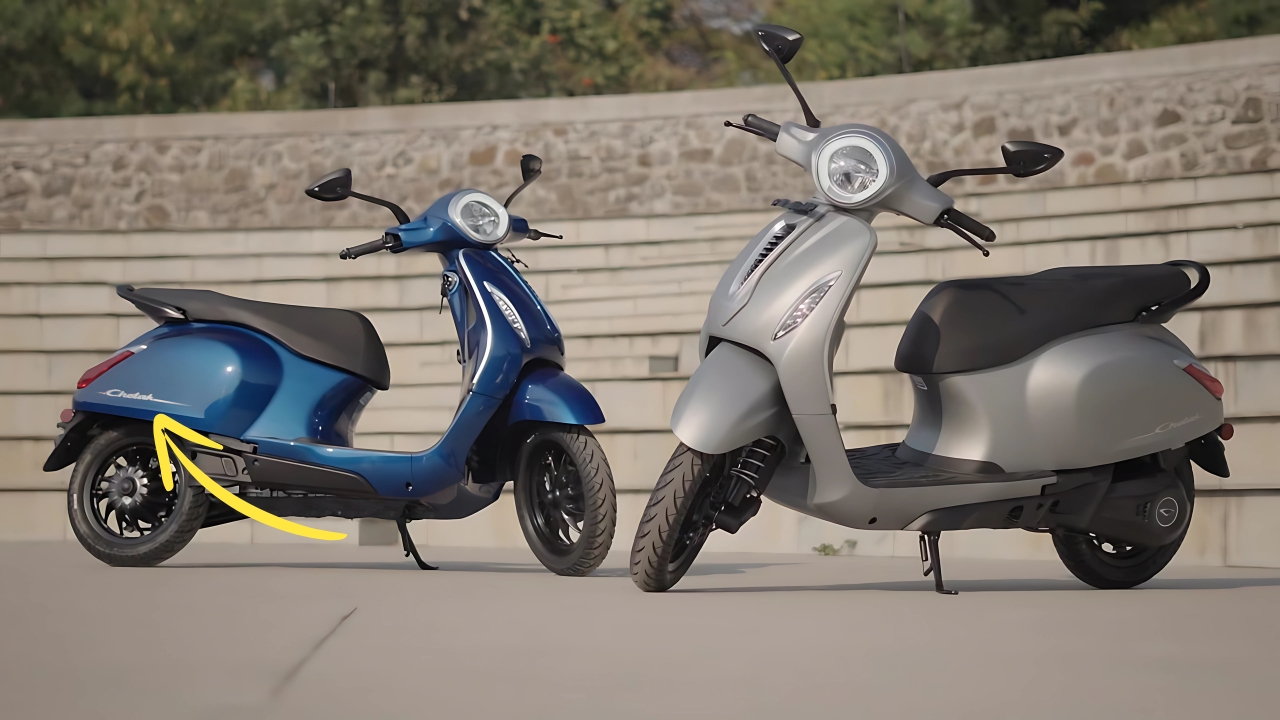Bajaj Chetak Electric: Few vehicle names carry the cultural weight in India that “Chetak” does. The original Bajaj Chetak, manufactured from 1972 to 2006, transcended mere transportation to become a symbol of middle-class aspiration and reliability during decades of limited vehicle choices.
Bajaj’s decision to resurrect this storied nameplate for their first electric scooter demonstrates both marketing savvy and considerable confidence in the product’s quality.
Having spent the past two weeks with the latest iteration of the Chetak Electric during an extended stay in Pune, I’ve developed nuanced impressions about where this modern revival succeeds in honoring its heritage while embracing an electric future.
Bajaj Chetak Electric: Historical Context: Understanding the Chetak Legacy
To properly evaluate the Chetak Electric, one must first acknowledge the immense historical significance of the original model. Named after legendary ruler Maharana Pratap’s horse, the first-generation Chetak became so deeply embedded in Indian culture that it featured in everything from Bollywood films to wedding dowries.
Families often waited years on delivery waiting lists, and the scooter’s legendary durability meant many examples remained in service for decades – creating intergenerational attachments that few consumer products achieve.
This historical weight created both opportunity and challenge for Bajaj’s electric revival. The nameplate offered instant recognition and positive associations, but also established elevated expectations for build quality, reliability, and longevity that more recently established electric two-wheeler brands might escape.
The decision to position the new Chetak as a premium offering rather than competing directly on price with emerging startups reflects recognition of these heritage expectations.
Design Philosophy: Retro-Modern Fusion
The Chetak Electric’s exterior design successfully balances nostalgic references with contemporary execution.
The rounded body panels and flowing curves echo the original model’s iconic silhouette while incorporating modern elements like full LED lighting and digital instrumentation.
The metal body construction – unusual in an era where most scooters utilize plastic panels – provides both visual and tactile quality that enhances the premium positioning while referencing the original’s all-metal construction.
Color options demonstrate similar thoughtfulness, with the “Indigo Metallic” of my test unit offering sophisticated depth that shifts under different lighting conditions.
The minimalist badging and absence of graphics create clean visual lines that avoid the busy styling common on many contemporary scooters.
Chrome accents on the mirrors, headlamp surround, and side panels provide just enough brightwork to reference classic scooter aesthetics without appearing excessive.
What impresses most about the design execution is its restraint – unlike many “retro” designs that incorporate awkward vintage elements onto modern platforms, the Chetak Electric achieves a cohesive aesthetic that feels neither derivative nor contrived.
During my time riding around Pune, the scooter consistently gathered attention and sparked conversations with both younger riders and older citizens who recalled the original model, suggesting the design successfully bridges generational divides.
Riding Experience: Refined Electrification
The Chetak Electric’s performance characteristics reflect its premium positioning within the electric scooter segment. The 3.8kW motor delivers 16Nm of torque – modest figures on paper that translate to surprisingly satisfying real-world performance due to the instantaneous torque delivery characteristic of electric motors.
Acceleration from standstill proves particularly impressive in urban environments, allowing confident navigation of Pune’s often chaotic traffic patterns.
Two riding modes (Eco and Sport) offer meaningful differentiation in performance and range. Eco mode limits top speed to approximately 60 km/h while maximizing efficiency, while Sport mode increases responsiveness and raises the top speed to around 70 km/h.
This implementation avoids the excessively restricted feel some competitors’ economy modes exhibit, creating options that feel like genuine choices rather than severe compromises.
The ride quality benefits significantly from the robust chassis construction and thoughtful suspension tuning.
The telescopic front fork and rear monoshock absorb urban road imperfections effectively, creating a planted feel that inspires confidence even on Pune’s occasionally challenging surfaces.
The 12-inch wheels strike an effective balance between maneuverability and stability, while the 173mm ground clearance provides adequate clearance for typical urban obstacles without creating an excessively tall riding position.
Perhaps most impressive is the refinement that permeates the riding experience. The near-silent operation, smooth power delivery, and absence of vibration create a serene quality that conventional scooters cannot match regardless of price.
This refinement aligns perfectly with the premium positioning while creating genuine differentiation beyond mere powertrain technology.
Practical Considerations: Everyday Usability
The Chetak Electric’s practicality for daily usage demonstrates similarly thoughtful execution.
The 3kWh lithium-ion battery provides approximately 95km range in Eco mode and 75km in Sport mode based on my real-world testing – figures that proved entirely adequate for urban commuting with charging every 2-3 days depending on distance covered.
The non-removable battery configuration might disadvantage those without dedicated home charging capabilities, though Bajaj’s expanding dealer network partially mitigates this limitation.
Charging requires approximately 5 hours from a standard household outlet – longer than some competitors but reasonable for overnight replenishment. The inclusion of regenerative braking helps extend range during city riding with frequent deceleration, while the intelligent battery management system protects against extreme temperature conditions common in Indian climate.
Storage capacity represents one area where modern expectations required deviation from the original Chetak’s limitations.
The under-seat storage accommodates a half-face helmet alongside personal items, while the flat floorboard provides additional carrying capacity for grocery bags or small packages.
The USB charging port in the front glove box demonstrates attention to contemporary needs, allowing device charging during commutes.
The digital instrument cluster delivers essential information through an intuitive interface, with the smartphone connectivity providing additional functionality through Bajaj’s companion app.
This connectivity enables features like theft detection, remote immobilization, and ride statistics that enhance ownership without introducing unnecessary complexity to the core riding experience.
Ownership Proposition: Premium Value
The Chetak Electric’s value proposition extends beyond immediate specifications to encompass the total ownership experience.
Priced at approximately ₹1.5 lakh (ex-showroom), it positions as a premium offering compared to several newer market entrants, though this pricing reflects the metal construction, refined engineering, and established service network that support long-term ownership satisfaction.
Bajaj’s reputation for durability and parts availability creates confidence in long-term support that many electric startups cannot match, while the three-year/50,000km warranty on the powertrain components addresses common concerns about battery longevity.
The minimal maintenance requirements – with no oil changes, air filter replacements, or exhaust system concerns – create meaningful operating cost advantages over conventional scooters despite the higher initial investment.
Bajaj Chetak Electric: Heritage Reimagined
The Bajaj Chetak Electric ultimately succeeds by honoring its namesake’s legacy through contemporary execution rather than mere nostalgia exploitation.
Its combination of refined engineering, thoughtful design, and established manufacturer support creates a compelling proposition for urban commuters seeking premium electric mobility from a brand with proven longevity.
While not competing directly on specification or price with the most aggressive market entrants, the Chetak Electric offers intangible value through its quality construction and cultural significance that transcends comparison spreadsheets.
In reimagining an iconic model for a new era of mobility, Bajaj has created not merely an electric scooter but a worthy inheritor of a storied nameplate that deserves its place in India’s evolving transportation landscape.

